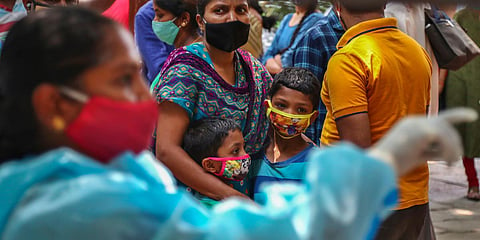

The Union government’s decision to cancel the CBSE Class 12 board exams ends the prospect of students having to take the examination amidst a pandemic that has infected three crore Indians. The ferocity of the second wave and the prospect of a devastating third wave have influenced the Centre’s thinking. The decision comes more than a year since the first lockdown in April 2020 shut schools for 24 crore children.
Over the past year, students and teachers have had to adapt to the ‘learning from home’ model, where digital became the dominant medium. This forced change, however, is hardly desirable and the digital divide is leaving behind crores of children. Digital education favours the privileged children who had better learning outcomes even before the school closure. While there are stories of dedicated teachers visiting children at home or teaching in school playgrounds, these solutions are not scalable. The result is a worsening of the silent learning crisis that has been plaguing our children since before the pandemic.
Apart from impacting learning, school closures have also affected children’s health. The health ministry informed Parliament that there had been a 31% drop in vaccinations during April to June 2020, many of which are carried out in schools and anganwadis. Over 10 crore children have also been deprived of mid-day meals, which have been instrumental in reducing child malnutrition. Finally, there are children among the 23 crore Indians who have been pushed into poverty and will never return to class. Schoolgirls face the grim prospect of being forced into marriage or being trafficked.
In sum, prolonged school closures have reversed decades of gains in enrolment, learning and children’s health. We are yet to come to terms with this challenge. The first step must be reopening schools after vaccinating all children, teachers, and support staff. For this, the Centre must prioritise vaccinating children between 12 and 18 years. But none of the vaccines being used in India have been approved for children. Bharat Biotech’s Covaxin and Zydus Cadila’s ZyCoV-D are currently undergoing trials among children but awaiting regulatory clearance. Even after approval, Covaxin’s availability will be a challenge because it accounts for less than 10% of the doses administered. However, there are global alternatives.
The US-made Pfizer-BioNTech mRNA vaccine is already being used by advanced economies like America, Canada, the European Union, Singapore, Japan and Israel to vaccinate children. More than 65 lakh children in the US have already received a dose.Reports claim that Pfizer will supply five crore doses to India. The Centre must fast-track this import agreement and direct these doses towards children between ages 12-18 years.The approval process can be fast-tracked because of the waiver for bridging trials of vaccines approved by the WHO or in the US, UK, Europe or Japan.
Yet, securing the vaccines is only half the battle. We must also work towards rapid inoculation of children. Three broad solutions can be suggested here.
First, prioritise children in rural and remote areas with low internet connectivity and smartphone penetration. Schools should be used as walk-in vaccination centres where children can enter their classrooms and get vaccinated in a comfortable environment. Children who are not enrolled should be allowed to walk into their nearest school to get a jab.
Second, vaccine hesitancy remains a problem in rural India. To alleviate this, state governments should actively encourage gram pradhans to spread positive messaging around vaccinations amongst parents and community elders in their villages. Teachers can also be asked to speak with their student’s parents to increase vaccine awareness.
Third, there is a gender gap in the current vaccination drive—for every 1,000 men vaccinated, there are only 871 women inoculated. This gap may worsen with children as parents may prioritise vaccinating boys over girls.To solve this, state governments can link existing schemes of cash transfers for sending girls to school with their vaccination status. Research shows that these incentives in the case of BCG and pentavalent vaccines had a large positive impact on vaccination rates.
With a fast-track import agreement and a mission-mode inoculation drive, our children can dream of re-entering classes within this year. The priority should be reopening upper primary, secondary and senior secondary classes in rural areas. This can be done by vaccinating the roughly 10 crore rural children aged 12-18 years. The Centre should target reopening schools by November so that children can celebrate Children’s Day on November 14 in their school. This will mean vaccinating 16 lakh children in rural areas daily between July and November. While this is a tall order, pursuing it will save another academic year from being washed out.
There are many Indian policymakers who hope for a Roaring 20s post-pandemic decade where India’s economy will grow rapidly. They would do well to remember that the worsening silent learning crisis among our children can seriously undermine this possibility. But we have the solution—vaccinate children and reopen schools.
Lavu Sri Krishna Devarayalu
YSRCP MP from Narasaraopet, Andhra Pradesh
(Assisted by Raghav Katyal, LAMP Fellow)
(krishna.lavu@yahoo.in)